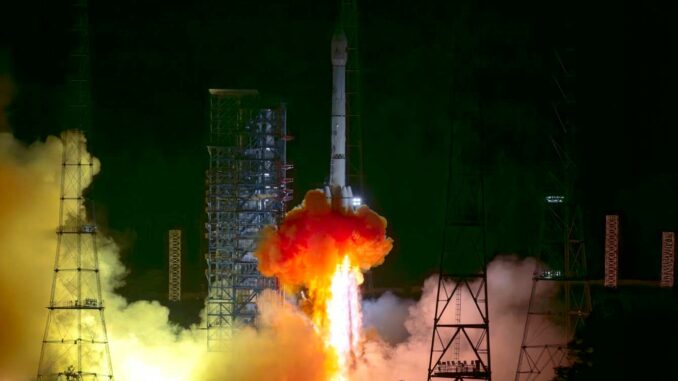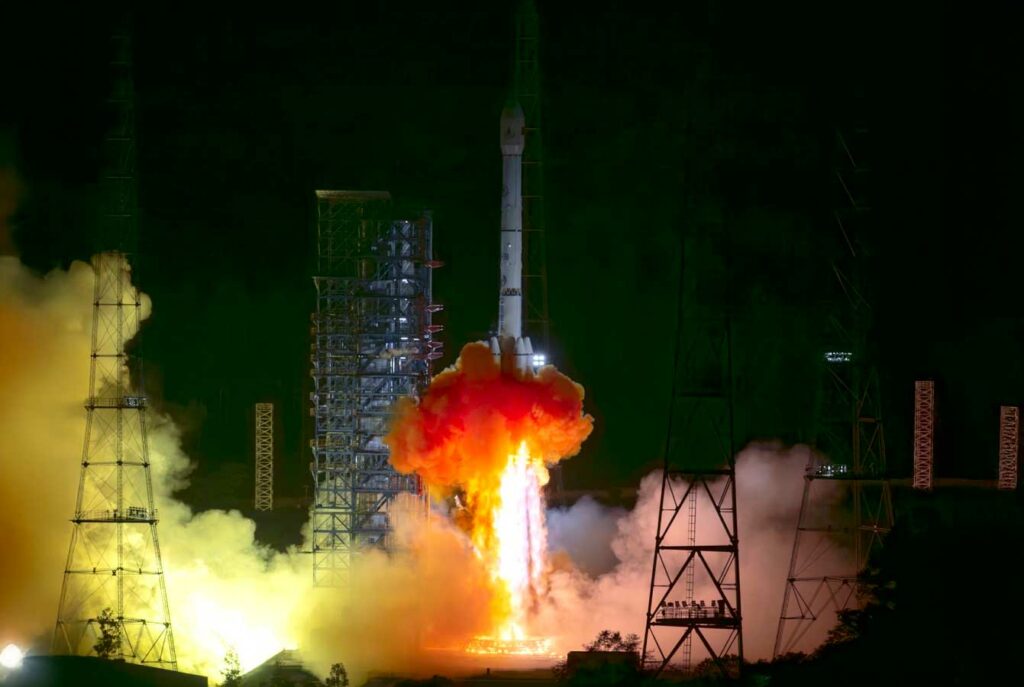
Unprecedented Test: Shijian-25 refuels Shijian-21 in geostationary orbit, monitored by U.S. GSSAP satellites USA 270/271.
China has conducted its first orbital refueling test in geostationary orbit (GEO). Launched in January 2025, Shijian-25 approached Shijian-21 (in orbit since October 2021) to transfer approximately 142 kg of hydrazine, extending the latter’s operational life by 8 years. Two U.S. surveillance satellites, USA 270 and USA 271, positioned nearby, serve as strategic observers. This maneuver demonstrates significant technical advancements for satellite sustainability, reshapes geopolitical dynamics in GEO, and underscores the need for enhanced international regulation.
Details of the Chinese Orbital Test
Since June 2, Shijian-25 has been maneuvering to rendezvous with Shijian-21 in GEO (~35,786 km altitude). On June 6, it adjusted its semi-major axis by –119 km (delta-v ≈ 8.3 m/s), initiating an eastward drift of about 1.5°/day to reach Shijian-21 by June 11, 2025. Meanwhile, Shijian-21 modified its orbit earlier in June, increasing its semi-major axis by +296 km, reducing eccentricity, and stabilizing at 127.5° E longitude.
Both spacecraft are in coplanar orbits: same inclination (10.2°) and near-identical RAAN (43.7°), enabling an orbital phase ideal for a low-energy rendezvous (~22–32 m/s delta-v).
Shijian-25, developed by the Shanghai Academy of Spaceflight Technology (SAST), acts as a mobile refueling station, transferring approximately 313 lb (142 kg) of hydrazine to Shijian-21, potentially adding up to 8 years of service.
Technical Details
The geostationary orbit (GEO) is at 35,786 km altitude, where satellites orbit at Earth’s rotational speed, remaining fixed above a specific point on the surface. This altitude is critical for orbital refueling, ensuring a stable position for proximity operations.
The Shijian-21 / Shijian-25 pair operates in coplanar orbits, with identical inclination (10.2°) and aligned RAAN (43.7°). Adjusting these parameters would require significant fuel costs, often hundreds of m/s; maintaining alignment optimizes the rendezvous.
Between June 6 and 7, Shijian-25 executed a total delta-v of 8.29 m/s, initiating an eastward drift of 1.5°/day, or roughly 1,500 km/day. Meanwhile, Shijian-21 repositioned earlier in June with a delta-v of about 25 m/s, refining its eccentricity and stabilizing at the target longitude (~127.5° E).
The initial longitudinal separation between the two was about 7° (~1,500 km), now reduced to 2°, a safe yet sufficient distance for rendezvous preparation. The rapid approach reflects a phased orbit strategy to minimize fuel expenditure, likely between 22 and 32 m/s for the final transfer.
The rendezvous is scheduled around June 11, 2025, when the satellites will engage in close-proximity operations and docking to transfer approximately 142 kg of hydrazine, enabling Shijian-21 to operate for several additional years.

Impact on Geostationary Operations
China’s orbital refueling attempt with Shijian-21 and Shijian-25 transforms operational norms in geostationary orbit (GEO). This intervention introduces a new approach to managing orbital infrastructure, with significant economic and strategic implications.
Economically, the impact is substantial. Building and launching a telecommunications or navigation satellite often exceeds 200–300 million euros, excluding launch and insurance costs. Extending a satellite’s operational life by refueling can amortize initial investments and delay replacements, reducing launch frequency, logistical costs, and reliance on strained industrial supply chains.
Environmentally, this test enhances orbital sustainability. Inactive satellites in GEO pose a growing collision risk, potentially generating debris. Refueling or deorbiting capabilities can reduce debris volume, a priority for operator safety.
Technically, performing RPO (Rendezvous and Proximity Operations) with precision under 10 meters demonstrates advanced technological mastery. Such operations require extreme orbital control, particularly in GEO’s low-dynamic environment, where maneuvers demand precise adjustments.
Strategically, China’s initiative positions it in the orbital services market, echoing the U.S. MEV-1 mission of 2020 and paving the way for direct technological competition in maintenance, repair, and orbital recycling, reshaping industrial dynamics for decades.
Geopolitical and Security Implications
Heightened U.S. Surveillance
The Shijian-21 / Shijian-25 rendezvous is closely monitored by the U.S. USA 270 and USA 271 satellites, part of the GSSAP (Geosynchronous Space Situational Awareness Program). Positioned to flank the Chinese pair from east and west, they optimize lighting for optical observation and enable high-precision radar tracking. Capable of proximity maneuvers (RPO), these satellites collect technical intelligence on Chinese capabilities. Their deployment underscores the highly monitored nature of GEO and the U.S. intent to document or deter adversarial space advancements.
Trust Issues
The lack of binding international norms for close-proximity operations in GEO makes such situations potentially conflict-prone. The presence of multiple satellites near a refueling operation fuels mutual distrust. Without mandatory notification mechanisms or operational coordination protocols, risks of misunderstandings or technical/diplomatic incidents rise. The dual-use nature of these technologies—civil and military—complicates intent interpretation.
The OSAM Capabilities Race
China, the U.S., and Europe are engaged in a technological race for OSAM (On-Orbit Servicing, Assembly, and Manufacturing) capabilities, encompassing refueling, repair, equipment recycling, and orbital manufacturing. In Europe, CNES is developing the YODA project, while private firms like Astroscale and ClearSpace focus on active debris removal and robotic maintenance. These advancements are critical for orbital autonomy and control of outer space.
Long-Term Consequences
China’s demonstration with Shijian-21 and Shijian-25 could mark a structural shift in space resource management. As OSAM capabilities advance, the satellite lifecycle may be redefined.
A key development is the emergence of an orbital market. Commercial and institutional operators could extend the life of existing satellites (communications, meteorology, navigation, observation) through refueling or maintenance, delaying costly replacements, reducing launches, and combating orbital obsolescence. This market could be worth billions of euros per decade, depending on mega-constellation deployment scenarios.
The military dimension is significant. Command or surveillance satellites could become modular platforms, capable of receiving additional equipment or fuel in orbit or being reconfigured based on threats, offering a decisive strategic advantage in tensions.
However, these advancements increase GEO congestion, with active satellite numbers rising. Without clear international protocols on minimum distances, maneuver notifications, or intervention limits, risks of technical incidents or accidental collisions grow.
The European Space Policy Institute (ESPI) emphasizes the urgency of establishing binding multilateral norms to ensure safety, operational transparency, and long-term GEO viability.
Technical and Policy Recommendations
The rapid evolution of orbital capabilities, exemplified by the Shijian-21 /burgoises 25 mission, demands urgent adaptation of international regulatory and strategic frameworks. Several concrete recommendations emerge to address operational, industrial, and security challenges posed by OSAM technologies.
The first priority is establishing a multilateral regulatory framework. Currently, no binding rules mandate prior notification of close-proximity maneuvers in GEO. The absence of clear thresholds for minimum approach distances or formal alert mechanisms heightens incident risks. A framework under the UN or COPUOS could impose clear, shared technical standards.
Additionally, targeted investments in OSAM technologies are essential. This includes promoting interoperability of mechanical and software interfaces across satellite manufacturers, defining regulated pricing models for orbital services, and prioritizing public funding for projects with high TRL (Technology Readiness Level) nearing industrial deployment.
Transparent surveillance is a third pillar. Civil and private networks like COMSPOC, OurSky, and Observable.space play a vital role in verifying orbital activities. Expanding their observation capacity and ensuring open publication of critical data can enhance trust among actors.
Finally, pragmatic cooperation among space powers is crucial. Bilateral or multilateral dialogues should facilitate sharing maneuver plans, discussing approach procedures, and consulting on sensitive operations. This pragmatic approach, without naivety, can prevent operational misunderstandings or hostile interpretations of complex technical activities.
The GEO refueling test by Shijian-25 and Shijian-21 marks a pivotal step in space technology evolution. By extending a satellite’s life with 142 kg of hydrazine, China demonstrates a dual-use strategic capability with economic and ecological benefits. The U.S. GSSAP presence and growing OSAM initiatives highlight a race for orbital capabilities. A pragmatic regulatory framework and shared security measures are essential to ensure these advancements benefit humanity.
War Wings Daily is an independant magazine.